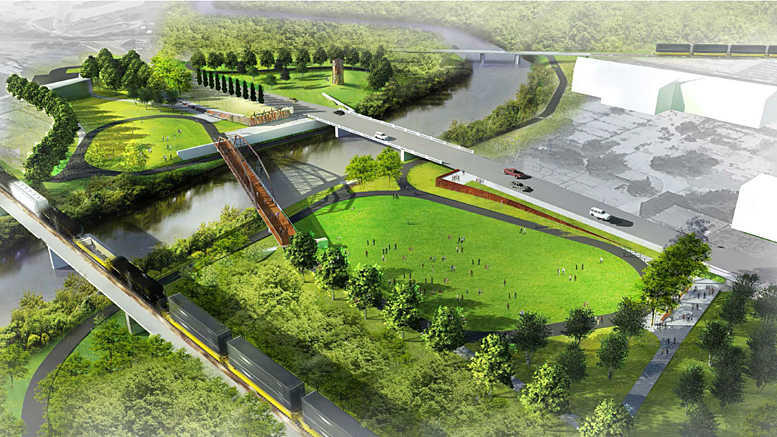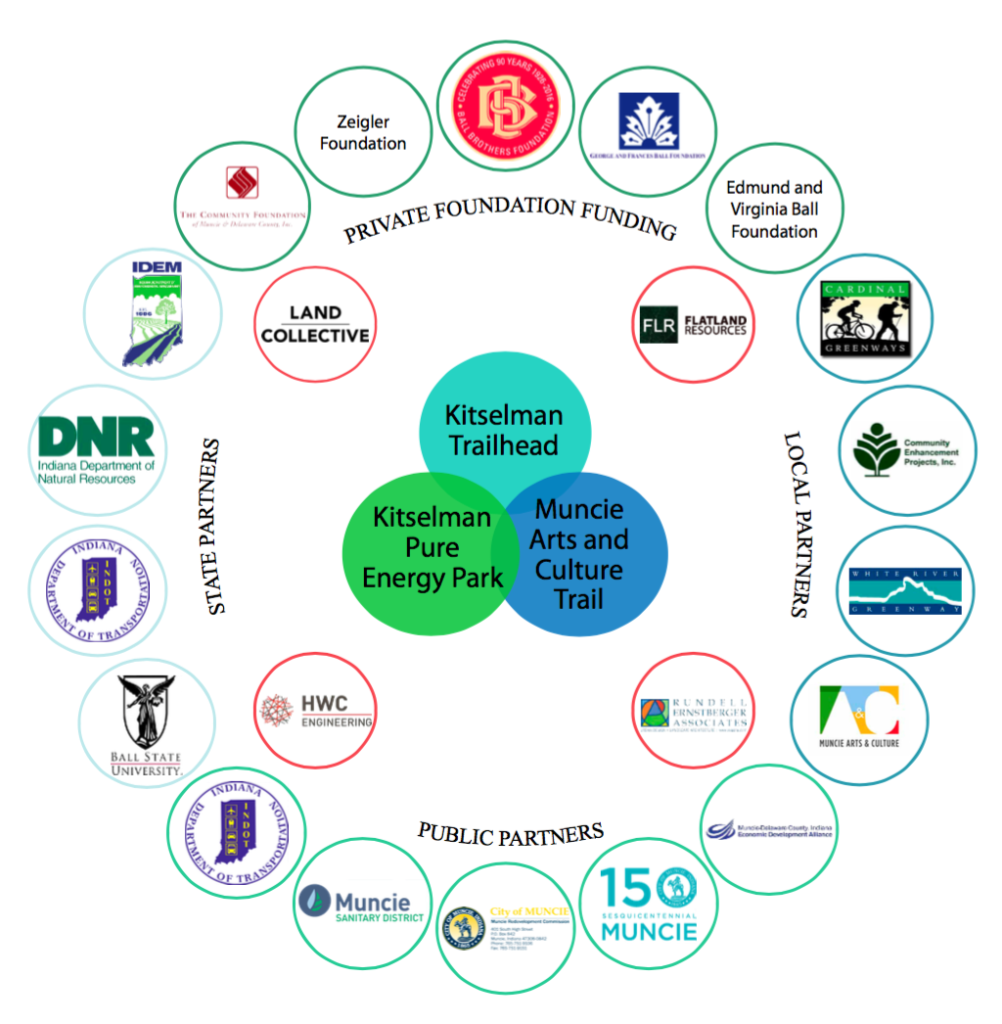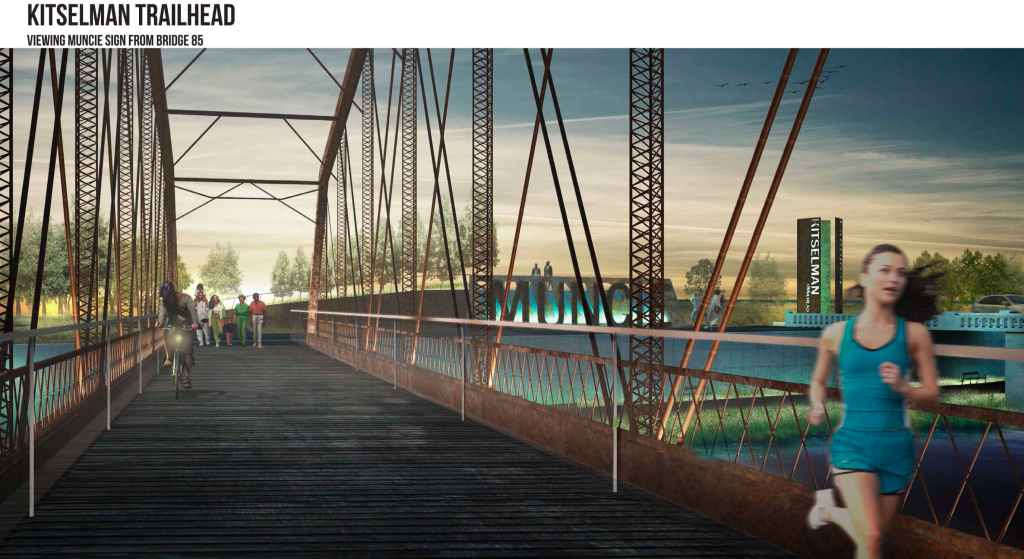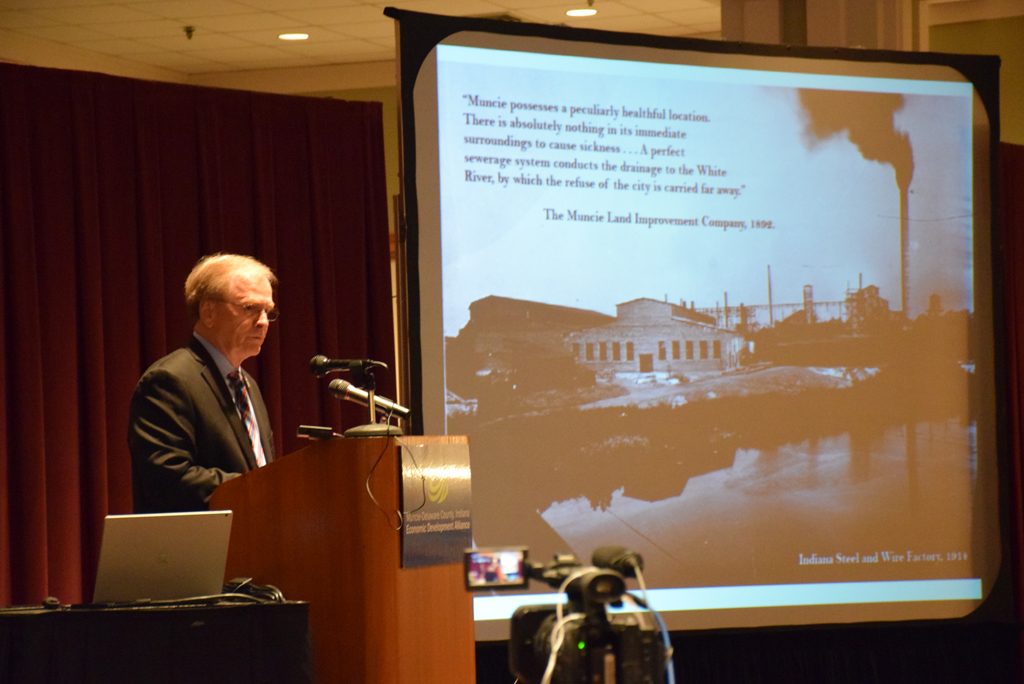By: Muncie-Delaware County Economic Development Alliance—
Muncie, IN—The City of Muncie, Cardinal Greenways, INDOT and KPEP—the Kitselman Pure Energy Park—continue in cooperation to revitalize the former Indiana Steel and Wire and King Indiana Forge brownfield factory areas on the east side of Muncie.
“People traveling along East Jackson Street have noticed the early beginnings of the reconstruction efforts with the installation of construction fencing around Indiana Steel and Wire”, says Mayor Dennis Tyler. “Soon, INDOT will be installing temporary signals for the INDOT East Jackson Street Bridge reconstruction that is expected to take about 3 years to rebuild. While INDOT is working on the Jackson Street Bridge, the City of Muncie will begin to construct the first phase of the Kitselman Trailhead with the reinstallation of the historic Albany Bridge.”
The Kitselman Trailhead, the INDOT East Jackson Street Bridge and KPEP are 3 separate projects. Each project is financed and managed by separate organizations. INDOT’s Jackson Street Bridge is funded by the Federal Highway Administration. KPEP is funded by a private developer. The Kitselman Trailhead has many funding sources both public and private: INDOT, Indiana DNR, The Community Foundation of Muncie & Delaware County, Inc., Community Enhancement Projects, Inc., Ball Brothers Foundation, Edmund F. and Virginia B. Ball Foundation, City of Muncie and Muncie Sanitary District.
The Kitselman Trailhead project is being implemented through a partnership with the Community Enhancement Projects, Inc., Cardinal Greenway and the City of Muncie. HWC Engineering, DAVID RUBIN Land Collective and Flat Land Resources are engineering, landscape architectural design, and project management professionals coordinating the day-to-day efforts of the trailhead project.
David Rubin, a landscape architect and founder of DAVID RUBIN Land Collective based in Philadelphia, created the master plan for the Kitselman Trailhead. He explained that, “The notion of transforming an empty, industrial, blighted brownfield area that once polluted and almost killed the White River into a pedestrian-friendly trail and river-centric greenfield landscape surrounded by green technology businesses is the collective consciousness of the entire Muncie community, redefining itself as Middletown USA for the next 100-years and beyond. The Kitselman trailhead design is the renaissance, reinvention and transformation from Muncie’s industrial heritage to the alternative energy revolution by celebrating art, nature, history and recreation in the embrace of new technologies. Quality of place is the future trademark of a vibrant and thriving city.”
The Land Collective plan for the Kitselman Trailhead embraces history by reusing historic Bridge 85. The trail design will lead visitors to the tranquility of the river, completely separated from automobile traffic. People traveling through the site on State Road 32 during their daily commute to and from work will be touched by the grace of art in the old bridge, a new City gateway sign constructed from corten steel all couched against the backdrop of nature, enveloped by factories and railroads.
The Kitselman Trailhead project has been divided into three construction phases. Phase 1 is the restoration and installation of the old Bridge 85 also known as the Albany Bridge and temporary trail connections to Cardinal Greenway. Phase 2 is the construction on the eastern side of the river and the former Indiana Steel and Wire employee parking lot, including a White River Greenway trail connection from the Craddock Wetland at Gavin Street to the relocated Albany Bridge and a large lawn area being constructed on the old parking lot. Phase 3 is the construction of the west side of the river which includes areas of the former King Forge property. The final phase of the trailhead project will include large art sculptures that also act as gateways to the City.
“Each phase of the Kitselman Trailhead will be transformative. With the Albany Bridge in the first phase, the White River Greenway trail connection in the second, and the new City of Muncie gateway art pieces in the final and third phase, it is hard to decide which phase will have the greatest impact to this blighted area of town,” says Angie Pool, Cardinal Greenway CEO. “I am so excited and waiting to see the Muncie gateway sign, in the third phase, which is designed to include Ball jar blue glass that will be backlighted at night.”
Mark Peters, developer of the Kitselman Pure Energy Park (KPEP), explains, “The Kitselman Trailhead is the main attraction to which KPEP is adjoined and the reason we are excited about the new Gateway to Muncie. We’ve completed the demolition work on the former Indiana Steel & Wire property and have moved into construction. We will be relocating Bunch Boulevard in synch with the INDOT’s East Jackson Street Bridge reconstruction. The relocation of Bunch Boulevard from its current location to a new location about 300 feet more to the east will better serve the KPEP entrance, the Kitselman Trailhead parking lot, and make that area safer for drivers, riders and pedestrians.”
KPEP has also planned trails and wide sidewalks throughout the mixed-use development so people working and living in the surrounding neighborhoods can safely get to the Kitselman Trailhead, the White River and Cardinal Greenways. The site will include a five-megawatt solar power plant, community center with educational classrooms, headquarters building for DD Dannar and mid-sized hotel. There will also be electric charging stations, among other elements.
“Working collaboratively, the Kitselman Trailhead design has been carefully integrated into the KPEP development and INDOT’s Jackson Street Bridge project. The trail layout completely separates the automobiles from the trail users. Once the projects are completed, a person on the Cardinal Greenway will be able to get to the White River Greenway by crossing under the East Jackson Street Bridge on both sides of the river. People riding on the Cardinal Greenway will no longer have to cross Jackson Street making it safer for all”, explains Marta Moody of the Delaware-Muncie Plan Commission.
The East Jackson Street Bridge is one of the top five most highly travelled streets in and out of Muncie. Thousands of cars traveling to and from the Winchester, Farmland, Parker City, and Selma areas for work at Muncie downtown businesses, Ball State University and the IU Ball Memorial Hospital use Jackson Street-State Road 32, on their daily commute.
“The East Jackson Street-State Road 32 Bridge will be operating as a single lane signalized road for up to 3 years beginning this summer,” Nathan Riggs, INDOT East Central District Information Director said. “INDOT has been working closely with the Kitselman project for several years to create common design elements and coordinate project timing.”
The INDOT project is divided into 3 phases. Phase 1 is the complete removal and reconstruction of the south side of the bridge. Phase 2 is the relocation of major phone and fiber optic lines from the north side of the bridge to the south side of the bridge. Phase 3 is the demolition and removal of the north side of the bridge and the relocation of Bunch Boulevard.
“As the project progresses, people will notice that the new East Jackson Street and Kitselman Pedestrian Bridges are being built higher than the existing East Jackson Street Bridge. The levees in this area of town do not meet the current levee standards. KPEP, INDOT and the City have worked closely to make sure each individual project works in unison to help upgrade the levees around the Kitselman area,” says Jacob Isenburg, PE, HWC Engineering, the bridge engineer for the Kitsleman Pedestrian Bridge.
Major construction of the trailhead area will begin this summer and continue for several years. A small part of the project is the planned removal of the abandoned Indiana Steel and Wire dam. First and foremost, removal of the dam is for safety.
“As Muncie continues to expand its love and celebration of the White River as our community’s greatest natural resource with our river parks, river overlooks, and bike trails, plus increased wildlife, the numbers of people fishing, paddling and tubing the river continues to increase. Removal of any of Muncie dams will prevent drownings in the dangerous toe waters of the dams. Beyond the safety benefits of removing the dam hazard, the removal of the dams will increase the fisheries, especially increase in small mouth bass population and fresh water mussels (clams) that are a necessary part of the river ecosystem. To see more people safely floating or fishing the river in town along the greenway is worth celebrating as a local economic success story. We should be proud of the recovery from the 1970’s when the river was so polluted that it was virtually a dead, open sewer. The entire Kitselman Trailhead project is the antithesis of industrialized and population growth that caused river pollution,” says John M. Craddock, Founder and Director Emeritus, Muncie Bureau of Water Quality.
Multi-year, multi-agency projects can be challenging but so rewarding when they succeed.
According to Mayor Dennis Tyler, “Early during my first term as Mayor, I was approached and told about the White River and Cardinal Greenway’s vision at the old wire mill. Being from Muncie all my life, and a fire fighter that made many runs to those huge factory buildings around that area, I thought at first that this was a close to impossible dream but, as I listened to the idea and learned that people like Marj Ziegler, John Craddock, Marta Moody, David Sursa, Dr. Pruis, Frank Ball, Doug Bakken, various County Commissioners and the Ball Foundations have worked or have been working judiciously on this project for almost 20 years, I listened more.
“I learned that the White River vision had been planned as five phases in 1995. I learned that the last phase was to connect the White River Greenway to the Cardinal Greenway via a bridge over the river between the two trails. I learned that this vision was created when the factories in the area were still operating on some level. I learned that most of the trailhead funds to build the project would be a combination of INDOT federal highways funds and privately raised matching dollars. I learned that the Albany Bridge, being relocated to the trailhead, was manufactured in Muncie at the Indiana Bridge Company, one of the longest continuous businesses in the County, possibly 3rd to Meeks Mortuary and Kirks Bike Shop.
“I learned, and think that this is one of the coolest parts of the project, that the idea for the trailhead was created and refined over several design charrettes by Ball State Landscape Architecture students and professors. The more I listened and learned, the more I realized that this is an “imagine the possibilities if we can work together project.” I look forward, as so many long time dedicated people do, to being the first group to cross the old Albany Bridge. I look forward to seeing the first ever eastern city gateway. I look forward to riding my bike safely without crossing the Jackson Street Bridge. Muncie will be proud of this legacy project for many years.”






